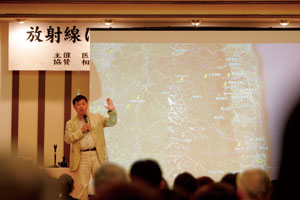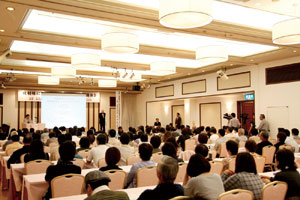Fukushima is not a dangerous zone any more
The risk of a thyroid cancer disappears.

The internal exposure of 20 children was measured at the hotel in Soma. High radiation was not detected from anyone.
After the measurement of the internal exposure was finished, the lecture by Professor Takada took place in the same hotel from 6:30 p.m., and about 300 people gathered from inside and outside the city.
“The radioactive iodine produced on March 11 has disappeared. It was not because Prime Minister Kan did his best to eliminate it. This is a physical law”, said the professor.
“The dose of radiation accumulated in children’s thyroid gland is 1/1000, compared with the Chernobyl disaster. I declare that no children will suffer from thyroid cancer in Fukushima. The risk of a thyroid cancer has disappeared. I can evaluate this result based on the total achievements of the past 20+-year-investigation in Russia.”
The prevailing reaction in the hall was a mix of surprise and suspicion. In fact, the professor investigated internal contamination in 40 Namie townspeople in April who took refuge beyond a 20-kilometer radius from the plant. At that time the dose of iodine accumulated in the thyroid gland was 3,600 Becquerels in the highest person. It was in the range of no thyroid cancer risk.

The results of the investigation were reported at the lecture that the risk of thyroid cancer had disappeared.
Truth be told, the occurrence of oncogenic health hazards caused by cesium has not been verified by the epidemiological study for 20 years after the Chernobyl disaster. (Cesium could induce leukemia etc. when a nuclear power plant worker is directly and massively contaminated.)
Professor Takada made the following conclusion: “One-year accumulated exposed dose in Fukushima residents is level D this year (refer to above figure). The level will fall more next year. According to the news, Fukushima was dangerous for radioactive contamination. However, my investigation shows that no Fukushima residents will suffer health problems from this nuclear power plant disaster.”
His confident opinion triggered a strong resentment from the residents. The local male doctor dogged Professor Takada after the lecture, saying “Why can you say that there is no health problem for children?” On the contrary, most participants seemed to accept Professor Takada’s firm commentary. A 43-year-old-woman who took refuge with seven families including schoolchildren from Minamisoma city to Fukushima city, said happily,
“I couldn’t really decide whether we should come back or not. The governmental release brought me to think that we would not be able to live any more here. But I’m relieved to hear his lecture. Now, I’ve decided to return together with my family and we will do our best.” Big drops of tears from her eyes spilt down her cheeks and her anxiety seemed to disappear.
Support people to put their lives back in evacuation zone

About 300 people gathered for the lecture from inside and outside Minamisoma.
The government designates the place likely of exceeding 20-mm sieverts of annual accumulated radioactive dosage as “specific areas recommended for evacuation”, and furthermore is going to expand the evacuation area.
Professor Takada takes a quite opposite view from the government. He insists that residents can return and rebuild their lives and jobs even though within the 20-km off-limits area and the scheduled evacuation zone such as Iitate village. For that purpose, “I would like to go into 20-km off-limits area to set measurement points, and to check for myself to verify whether those areas are safe or not.” he said.
It hasn’t been verified yet that areas in the scheduled evacuation zone such as Iitate village are places from which the residents should take refuge, or stay there until an annual accumulated radioactive dosage of cesium is predicted based on actual data obtained from personal dosimeters. We asked about ten percent of the residents there to put on the apparatus for checking.
The government measures only the dose of radiation in the atmosphere or the soil. It doesn’t measure the dose of each person exposed who is actually living in the area. Although the Fukushima prefectural authorities are trying to investigate all the people there, it just intends to follow up the health problems caused by radiation. Professor Takada points out that the governmental judgment is meaningless if we don’t measure how much radiation people are exposed to in actual daily life. Because a human being is not a scarecrow standing there, even though some places emit high radiation.



















